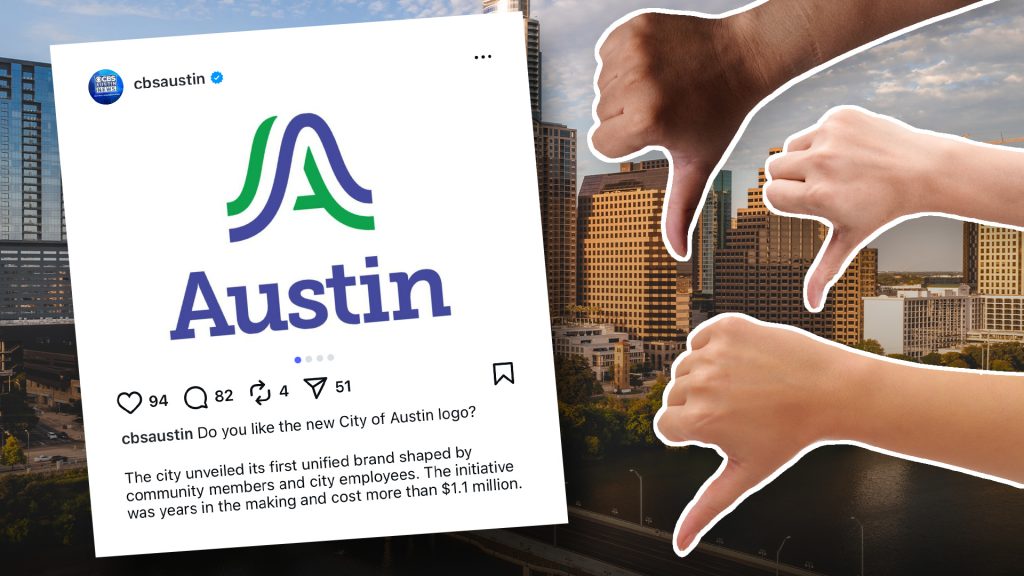Austin Texas’ new $1.1 million logo irked residents. So why do cities brand themselves anyway?

A cross-country road trip provides windshield views of wide-open highways, a diverse population and some great town slogans and logos. Drivers passing through Gettysburg, South Dakota, will learn it’s “Where the Battle wasn’t.”
Gas, Kansas, implores visitors: “Don’t pass gas, stop and enjoy it.”
And in San Andreas, California, the city that shares its name with the famous fault line reminds folks, “It’s not our fault.”
At their best, these logos and slogans are catchy enough to lodge into a passer-by’s brain. But what happens when a tax-payer funded rebrand doesn’t go over very well?
Austin, TX rebranding
Enter Austin, Texas, a city with the well-known slogan, “Keep Austin weird.”
It’s been around since 2000 and remains popular. Just ask Texas native Matthew McConaughey.
“The unwritten motto of Austin has been to ‘Keep Austin Weird,’” McConaughey has previously said. “The landscape has changed, but I hope that doesn’t change. It’s a cool spot. Hopefully it stays that way.”
While the slogan hasn’t changed, the city’s logo has. Austin recently unveiled a new green and violet logo meant to evoke the city’s hills and “violet crown skies.”

Unfortunately for the city, it went over with many residents about as well as the Cracker Barrel rebrand. The Austin CBS affiliate, KEYE, posted about the revamped logo on Instagram, and the comments came in hot.
“A great Waste Management company logo!” one user wrote. Others stuck to one-word responses like “nope” and “fail.” But the majority of complaints came from one very specific element of the rebrand: Its $1.1 million price tag.
“Come on ATX spend our tax payers money right,” one user wrote. “ChatGPT could’ve hooked y’all up with that Albertson style logo for free. When does the refund come in???”
“Years in the making? My child made something similar in an afternoon coloring class,” another comment read.
It even caused some disagreement between city officials. Jessica King, the city’s chief communications director came out of the gate with positive spin:
“We deliberately chose a mark that reminded us of movement to reflect how welcoming, flexible and resilient this community and our employees are,” King wrote in a statement. “And it’s important to remember that this cohesive brand is more than a logo – it’s a reflection of who Austin’s local government is and how it is represented.”
A former city councilmember was more aligned with the Instagram comments.
“A $1.1M ‘brand refresh’ does nothing to solve Austin’s real problems,” former Austin City Council Member MacKenzie Kelly told local TV station KUT. “City government should invest in services, safety and affordability, not logos. This is not One Austin. It is one expensive distraction.”
While branding can be important for city, logos aren’t always a difference-maker.
“I think a logo is rarely very important,” David Aaker, branding expert and author of the book, Aaker on Branding, told Straight Arrow News.
“A logo is a really tiny, tiny part of a brand,” Aaker said. “And if a logo works, it will connect to the brand, so it’ll be a visual. A much more important concept for a brand is a visual symbol, like the Sydney Opera House or the Statue of Liberty or the Transamerica building. So, visual imagery can be really important, but I wouldn’t spend a lot of time worrying about the logo.”
Big city branding
While Austin’s logo rebrand didn’t go over great, there are a lot of reasons why cities seek brand identity.
“It’s a thought that differentiates the city that ideally provides its secret sauce, or it maybe suggests something that you might not think of when you think of that city, because you kind of misperceive it,” Aaker told SAN. “Cleveland has one: ‘Cleveland Rocks.’ Well, that allows you to sort of break the perception that it’s just simply boring.”
Cleveland has since replaced that slogan, which remains popular among residents. Similarly, “What happens here, stays here” lives on in Las Vegas even after an official rebrand to “What happens here, only happens here” in 2020.
The Las Vegas Convention and Visitors Authority spent hundreds of millions of dollars marketing the original slogan. It worked. The campaign is widely considered one of the most successful tourism ad campaigns ever, and even made it into the advertising Walk of Fame.
“The city of Las Vegas has a logo and brand so that residents, businesses and visitors can easily identify city communications, services and facilities,” a city spokesperson told SAN. “This is key for items such as the city website, advertising for city events and social media so that those seeing communications may easily identify that they are looking at something produced by the city of Las Vegas.”
A few thousand miles away, New York City’s simplistic, “I love New York” declaration is another big-city big win, according to Aaker.

“They’ve hit a home run,” Aaker said. “It’s always hard to get the home run, but when you do, it can make a big difference. And New York has had some home runs, more than one, actually.”
One of the most famous slogans ever, it actually represents more than just the Big Apple (also a nickname that’s done very well). It represents the entire state of New York, though the city might benefit most.
“Branding is extremely important even for a city like New York, which has never struggled from a brand awareness standpoint, but we still know that the city doesn’t sell itself, and it’s still extremely important for us to brand the city and properly promote the city in a way that draws visitors,” Tiffany Townsend, executive vice president for global communications at New York City Tourism & Conventions, told SAN.
Townsend’s organization led a rebrand for the city just two years ago that follows in the footsteps of the famous “I Love New York” branding.

The new, slightly more inclusive, logo rolled out across all five boroughs following the COVID-19 pandemic, which hit the city hard.
“I think coming out of the pandemic felt like a new chapter and a new opportunity to rethink how you’re going to talk to the world,” Townsend told SAN.
Overall, Townsend said the rebrand was well received – though it did garner some negative reviews. But it escaped much of the heat currently blazing through Austin for one key reason: The NYCTC didn’t pay an outside organization to redraw the logo.
“We do so much of it in-house, which I think might be unique to us as a destination organization,” Townsend said. “We do most of our creative work in house.”
Small town branding
While cities like New York and Las Vegas are tourism hotbeds, small towns all around the country have their own fun slogans to reach similar – if smaller – goals.
“One of the other reasons for the tagline really, is to create visibility,” Aaker said. “And so you would probably easily forget that city, but that tagline is something that stays with you because it’s so humorous and unusual. And so, you will remember the tagline and therefore remember the city.”
Take Santa Claus, Georgia. Its longstanding tagline, “The city that loves children,” plays on the spirit of its fun name. The city also recently added a second tagline: “Believe.”

“We just had some [banners] made this year, and we’re incorporating both of those sayings,” Mayor Donita Bowen of Santa Claus told SAN. “So, we’ve got half of them that say, ‘the city that loves children,’ and the other half is saying, ‘believe.’”
The 204 residents of Santa Claus drive around roads like Dasher Street and Rudolph Way.
While their slogans are used on banners and memorabilia, much of the city’s charm comes straight from the name.
“It’s Santa Claus, you know?” Bowen said. “So especially in December, or actually starts in November, it kind of carries itself.”
The post Austin Texas’ new $1.1 million logo irked residents. So why do cities brand themselves anyway? appeared first on Straight Arrow News.





